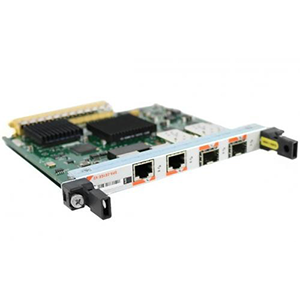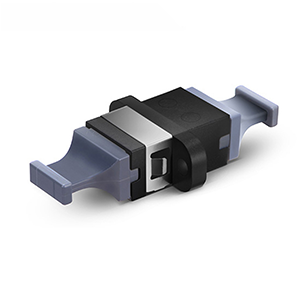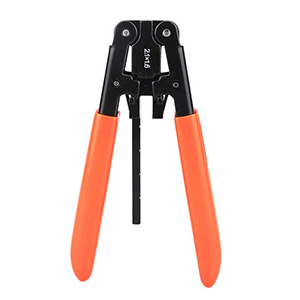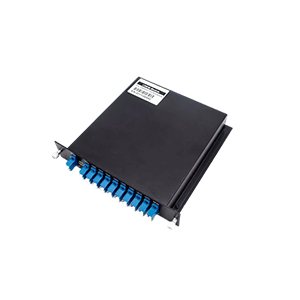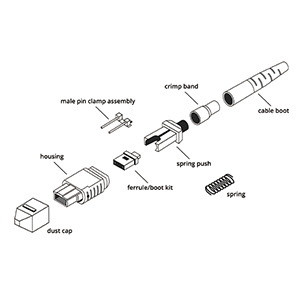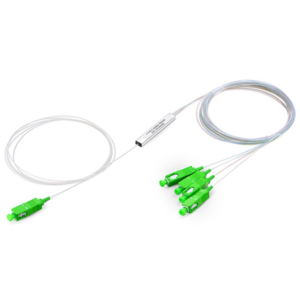SFP optical modules are widely used in modern networks. This article will explore the most common types of SFP optical modules on the market. We will first define the basic functions and characteristics of SFP optical modules and outline its important role in network transmission. Next, we will introduce several mainstream SFP optical modules, including SFP+ 10GbE, SFP28 25GbE, QSFP+ 40GbE and QSFP28 100GbE.
These optical modules support different Ethernet transmission rates and are used in different scenarios such as backbone networks, data centers and high-speed networks. Then, we will compare the differences between these SFP optical modules in terms of transmission rate, physical size, fiber type and power consumption. Finally, we will explain the key factors to consider when choosing SFP optical modules.
Overview of SFP optical modules
SFP (Small Form-factor Pluggable) optical modules are compact, pluggable optical fiber modules that are widely used in network equipment. It supports multiple data rates and wavelengths, and has the characteristics of flexibility and high performance. SFP modules allow for quick replacement and upgrades, and are suitable for a variety of fiber-optic communication applications.
Basic functions and features of SFP optical modules:
SFP (Small Form-factor Pluggable) optical modules are miniaturized, pluggable photoelectric conversion devices with the following main features:
(1) Miniaturized design:
- SFP modules use a smaller shell size, about 1 inch long.
(2) Pluggable structure:
- SFP modules use a pluggable interface design, which is easy to install and replace.
(3) Photoelectric conversion function:
- SFP modules can realize the conversion between optical signals and electrical signals.
In general, the SFP optical module is a compact and versatile optoelectronic conversion component, which is widely used in the interfaces of various network devices.
The role of SFP modules in network transmission:
SFP optical modules play an important role in network transmission:
(1) Realize the conversion from optical fiber interface to electrical interface:
- SFP modules can convert optical signals transmitted by optical fibers into electrical signals.
- Thus, the interconnection between optical fiber networks and electrical network devices is realized.
(2) Support high-speed data transmission and long-distance transmission:
- SFP modules can support high-speed transmission rates such as 1Gbps and 10Gbps.
- And can achieve long-distance optical transmission of tens of kilometers.
In short, SFP optical modules are key components that connect optical fiber networks and electrical networks, and play an important role in achieving high-speed, long-distance data transmission.
Common SFP optical module types
Common SFP optical module types include 1000BASE-SX, 1000BASE-LX, 10GBASE-SR, and 10GBASE-LR. 1000BASE-SX is used for short-distance transmission, 1000BASE-LX is suitable for long-distance transmission; 10GBASE-SR is used for short-distance connection of 10Gbps, and 10GBASE-LR supports long-distance transmission. These types adapt to different network requirements and transmission distances.
In the SFP optical module series, according to different transmission rates and interface specifications, the main types include the following common types:
1. SFP+ 10GbE optical module:
- Supports 10Gbps Ethernet (10GbE) transmission rate.
- Widely used in high-bandwidth environments such as backbone networks and data centers.
2. SFP28 25GbE optical module:
- Supports 25Gbps Ethernet (25GbE) transmission rate.
- Suitable for network application scenarios that require higher bandwidth.
3. QSFP+ 40GbE optical module:
- Supports 40Gbps Ethernet (40GbE) transmission rate.
- Mainly used in high-speed backbone network environments.
4. QSFP28 100GbE optical module:
- Supports 100Gbps Ethernet (100GbE) transmission rate.
- Used in ultra-high-speed network environments, such as data centers, cloud computing, etc.
In general, with the continuous growth of network bandwidth requirements, SFP and its derivative optical modules are also constantly developing towards higher rates to meet the transmission requirements of different application scenarios.
Main differences between different SFP optical modules
The main differences between different SFP optical modules include data transmission rate, wavelength and transmission distance. Modules such as 1000BASE-SX and 1000BASE-LX are suitable for gigabit rates, the former supports short distances, and the latter is suitable for long distances. 10GBASE-SR and 10GBASE-LR are used for 10Gbps transmission, corresponding to short-distance and long-distance requirements respectively. These differences determine their application scenarios.
1. Transmission rate and bandwidth support:
- SFP+ supports 10Gbps transmission
- SFP28 supports 25Gbps transmission
- QSFP+ supports 40Gbps transmission
- QSFP28 supports 100Gbps transmission
- The difference in transmission rate affects the overall bandwidth capacity of the network
2. Physical size and interface type:
- SFP series modules are smaller, about 1 inch long
- QSFP series modules are larger, about 2 inches long
- Interface types are also different, such as SFP and QSFP
3. Fiber type and transmission distance:
- Different module models may support different fiber types such as single-mode and multi-mode
- Transmission distances also vary, such as 10km, 40km, etc.
4. Power consumption and heat dissipation requirements:
- High-speed modules usually have higher power consumption and require stronger heat dissipation
- Low-speed modules have relatively lower power consumption
Comprehensive consideration of these differences is critical for selecting the right SFP optical module. The selection needs to be based on the specific network environment and bandwidth requirements.
Considerations for SFP optical module selection
When selecting an SFP optical module, data transmission rate, wavelength, transmission distance, and compatibility need to be considered. Rate and wavelength determine the performance and applicable scenarios of the module, and transmission distance affects the effective range of the signal. Compatibility ensures that the module matches the device. Taking all these factors into consideration, choosing the right SFP optical module can ensure the stability and efficiency of the network. The following key factors need to be considered comprehensively:
1. Compatibility of network equipment:
- Ensure that the selected SFP module is compatible with existing network equipment (such as routers, switches, etc.).
- Check the SFP module models and specifications recommended by the equipment manufacturer.
2. Actual application scenarios and requirements:
- Choose the right SFP module type according to the actual network environment and business requirements.
- Such as transmission rate, fiber type, transmission distance and other requirements.
3. Cost budget and reliability:
- Consider the purchase cost of the SFP module and try to reduce the cost as much as possible while meeting the requirements.
- Choose a reliable quality SFP module brand and model to ensure stable long-term operation.
4. Future upgrade needs:
- Evaluate the future bandwidth growth needs of the network and choose SFP modules with higher transmission rates.
- Leave ample room for future network upgrades and expansions.
Comprehensively weigh the above factors and choose the SFP optical module type that best suits your network needs, which can not only meet current requirements but also provide space for future development. This can maximize the role of SFP optical modules.
Summary
Choosing the right SFP optical module is crucial to building a high-performance and reliable network system. Our company has long focused on the research and development and application of optical module technology and has rich practical experience. We provide a full range of SFP optical module products, including various rate levels and transmission distances, which can meet the needs of different network scenarios.
Our SFP optical module products adopt industry-leading technical solutions and have achieved excellent levels in transmission performance, power consumption management and environmental adaptability. At the same time, our engineering team will provide you with professional demand analysis and solution design services to ensure that the deployed SFP optical module solutions can meet your actual needs to the greatest extent. Contact us now to learn more.
Common SFP FAQ
An SFP (Small Form-Factor Pluggable) transceiver is a compact, hot-swappable module used in networking equipment to provide connectivity over various types of media, including fiber optics and copper cables.
The most common types of SFPs include 1000BASE-SX (short-range multimode fiber), 1000BASE-LX (long-range single-mode fiber), 1000BASE-T (copper), and 1000BASE-EX (extended-range single-mode fiber).
1000BASE-SX SFPs are designed for short-range multimode fiber applications, typically up to 550 meters, while 1000BASE-LX SFPs are for long-range single-mode fiber applications, reaching distances of up to 10 kilometers.
A 1000BASE-T SFP is designed for Gigabit Ethernet connections over copper cabling (Cat5e/Cat6), supporting distances up to 100 meters. It is commonly used in environments where fiber cabling is not practical or available.
BiDi (Bidirectional) SFPs use a single fiber strand to transmit and receive data, utilizing different wavelengths for upstream and downstream traffic. This reduces the amount of fiber needed compared to standard SFPs, which require two strands.
A 1000BASE-EX SFP typically supports extended range single-mode fiber connections, reaching distances of up to 40 kilometers, making it ideal for long-distance networking applications.
SFP+ transceivers are an enhanced version of SFPs that support higher data rates, typically up to 10 Gbps, while maintaining the same form factor. They are backward compatible with standard SFP ports for lower-speed connections.
While SFP transceivers are often standardized, some brands implement proprietary coding that may restrict compatibility. It’s essential to check compatibility lists or use third-party SFPs that are coded for multiple brands.
CWDM (Coarse Wavelength Division Multiplexing) and DWDM (Dense Wavelength Division Multiplexing) SFPs are used for multiplexing multiple data signals onto a single fiber by using different wavelengths, allowing for higher bandwidth over long distances.
When choosing an SFP, consider factors such as the required data rate, the type of fiber (single-mode or multimode), the distance to be covered, compatibility with existing networking equipment, and whether specific features like BiDi, CWDM, or DWDM are needed.


